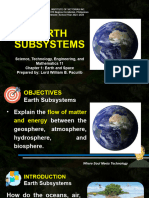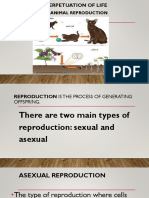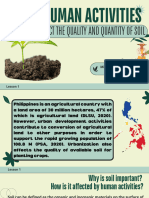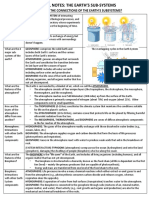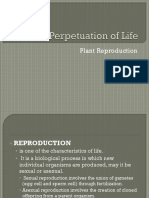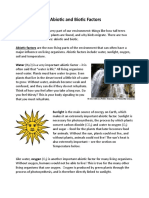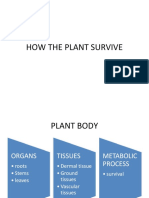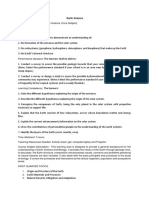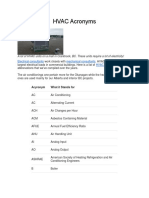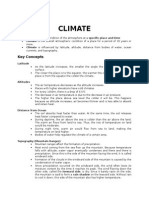Water Cycle
Water Cycle
Uploaded by
Chong Xue ErCopyright:
Available Formats
Water Cycle
Water Cycle
Uploaded by
Chong Xue ErOriginal Description:
Copyright
Available Formats
Share this document
Did you find this document useful?
Is this content inappropriate?
Copyright:
Available Formats
Water Cycle
Water Cycle
Uploaded by
Chong Xue ErCopyright:
Available Formats
WATER CYCLE
There are a number of steps involved in the water
cycle.
Step
The sun happens to be the driving force of the water
cycle. It heats up the water in seas, rivers, lakes and
glaciers, which evaporates and rises up in the
atmosphere.
Water is also evaporated through plants and soil through a
process called transpiration. This evaporated water is in
the form of water vapor, which cannot be seen with naked
eyes.
Step 2
This water vapor then comes in contact with air currents,
which take it higher into the atmosphere. After reaching
cooler temperatures, the water vapor condenses to form
clouds, which contain millions of tiny droplets of water.
Step 3
These clouds move all round the globe and grow in size
collecting more water vapor on their way. When it
becomes too heavy for the clouds to hold anymore water
vapor, they burst and the droplets of water fall back on
earth in the form of rain. If the atmosphere is cold enough,
the form of precipitation changes from rain to snow and
sleet.
Step 4
In the last step, rain or melted snow flows back into water
bodies like rivers, lakes, and streams. Rainwater is also
soaked up by the soil, through a process called infiltration
. Some of the water also runs off the surface or seeps in
the ground, which may later be seen as groundwater or
freshwater springs. Eventually the water reaches the
oceans, which are the largest water bodies and the
biggest
source
of
water
vapor.
This is a never-ending cycle, and all the water in the
oceans and other water bodies is subject to this cycle,
which
is
running
continually.
The water cycle happens to be a simple cycle, yet involves
a lot of processes.
Evaporation
When the heat of the sun causes water to turn to water
vapor, it is known as evaporation.
Condensation
As the water vapor moves higher in the atmosphere, it
cools down due to a decrease in the temperature. On
cooling, the water vapor condenses to form tiny droplets
of water. This process is known as condensation.
Precipitation
The tiny droplets of water that are formed as a result of
condensation keep on accumulating in the clouds. When a
cloud can no longer accommodate any more water
droplets, the water is released from them in the form of
rain,
hail,
sleet,
or
snow.
Transpiration
Plants absorb water from the soil and transport it to the
leaves via the stem. When this water evaporates from the
leaves and stem, it is termed as transpiration.
Infiltration
When the water on the surface of the earth seeps down
the ground, it is called percolation or infiltration. It later
forms
aquifers
in
low-lying
regions.
These were the major steps and processes involved in the
water cycle. A cycle - from water vapor in the air to
precipitation as rain - takes about nine days to complete.
The Carbon Cycle
In the atmosphere, carbon is attached to some oxygen in a gas
called carbon dioxide.
Plants use carbon dioxide and sunlight to make their own food and
grow. The carbon becomes part of the plant. Plants that die and
are buried may turn into fossil fuels made of carbon like coal and
oil over millions of years. When humans burn fossil fuels, most of
the carbon quickly enters the atmosphere as carbon dioxide.
You might also like
- Narrative ReportDocument3 pagesNarrative ReportToni100% (1)
- Water LilyDocument3 pagesWater LilyAJ Roa-Paloma PeneNo ratings yet
- Earth SubsystemsDocument50 pagesEarth SubsystemsLord William PacuribNo ratings yet
- UNIT 5 Climate ChangeDocument31 pagesUNIT 5 Climate Changesharmaine urbiNo ratings yet
- 4th Grade PLTWDocument25 pages4th Grade PLTWapi-418671570No ratings yet
- Earth Science 2Document32 pagesEarth Science 2Roejhen BalmacedaNo ratings yet
- Water Cycle WebDocument1 pageWater Cycle Webapi-260432014No ratings yet
- Module 1 Earthlife Sciences - Editedaug25 PDFDocument7 pagesModule 1 Earthlife Sciences - Editedaug25 PDFMaimai Adora SasaNo ratings yet
- PCS - Interview Intake FormDocument3 pagesPCS - Interview Intake FormBABA, ANGELITO C - ABM1No ratings yet
- Biological Importance of WaterDocument2 pagesBiological Importance of WaterHuyen Bui100% (1)
- Content Lesson PlanDocument7 pagesContent Lesson PlanLIEZEL C DELA PENANo ratings yet
- Perpetuation of Life (Plant Reproduction)Document15 pagesPerpetuation of Life (Plant Reproduction)Grace Gaje DizonNo ratings yet
- Earth Science Group 42Document35 pagesEarth Science Group 42Benedict Sadiwa GabrielNo ratings yet
- Light Yellow & Green Minimalist Agrifarm Company Profile PresentationDocument27 pagesLight Yellow & Green Minimalist Agrifarm Company Profile Presentationmikechristian073No ratings yet
- Earth Subsystem LC 4 6Document17 pagesEarth Subsystem LC 4 6Gennalyn Dela Cruz100% (1)
- Nutrtional Status 4 Nazareno 2022 2023Document5 pagesNutrtional Status 4 Nazareno 2022 2023Keithley AngueNo ratings yet
- What Is A Volcano?Document4 pagesWhat Is A Volcano?Sriram SusarlaNo ratings yet
- Hydrometeorological HazardsDocument15 pagesHydrometeorological HazardsMonver Rei AvestruzNo ratings yet
- Lesson 15 Knot TyingDocument19 pagesLesson 15 Knot TyingLawrence Angelo Mana-ayNo ratings yet
- Cornell Notes Earths Subsystem 2 Pages 1Document2 pagesCornell Notes Earths Subsystem 2 Pages 1Ericson Cec100% (1)
- Testing Water Quality LabDocument2 pagesTesting Water Quality Labapi-290100812No ratings yet
- Science4 Q1Document47 pagesScience4 Q1edcheyserrNo ratings yet
- Review Well Hehe Kaya Natin 2 Earth and Earth Subsystems: Earth: The Living PlanetDocument29 pagesReview Well Hehe Kaya Natin 2 Earth and Earth Subsystems: Earth: The Living PlanetColeen CalalangNo ratings yet
- Perpetuation of LifeDocument22 pagesPerpetuation of Lifemarizel salcedoNo ratings yet
- Volcanic HazardsDocument5 pagesVolcanic Hazardsalfredo cancioNo ratings yet
- Week 5-Earth-and-Life-ScienceDocument80 pagesWeek 5-Earth-and-Life-ScienceChaeyoung ParkNo ratings yet
- Abiotic and Biotic Factors DFDocument2 pagesAbiotic and Biotic Factors DFRonnel Manilag AtienzaNo ratings yet
- HYDROMETEOROLOGICAL PPT q4Document26 pagesHYDROMETEOROLOGICAL PPT q4Ivan RoiNo ratings yet
- Understanding Weather Fronts Using Surface Maps: NameDocument3 pagesUnderstanding Weather Fronts Using Surface Maps: Namekellie.collins.14No ratings yet
- How The Plant SurviveDocument16 pagesHow The Plant SurvivedhonaNo ratings yet
- The Unique Properties of WaterDocument3 pagesThe Unique Properties of WaterJodikaye Davis100% (1)
- I. Objectives: To Conserve and Protect The Soil?Document2 pagesI. Objectives: To Conserve and Protect The Soil?allanrnmanalotoNo ratings yet
- Q2 ES M5 Rock Behaviors Under Stress 1Document38 pagesQ2 ES M5 Rock Behaviors Under Stress 1tristanoxford798No ratings yet
- Formation of The Light Elements in The Big Bang Theory: Explanation and EvidencesDocument16 pagesFormation of The Light Elements in The Big Bang Theory: Explanation and EvidencesNYL BRIAN BUISERNo ratings yet
- Earth's SubsystemDocument31 pagesEarth's SubsystemElla RamirezNo ratings yet
- Earth As A System Earth Subsystems Internal StructureDocument23 pagesEarth As A System Earth Subsystems Internal StructureLovely Verzon100% (1)
- DRRR POWERPOINT Types of HazardsDocument19 pagesDRRR POWERPOINT Types of HazardsKelsey Gaile MaghanoyNo ratings yet
- Els&Esci Lesson1 Wk1Document84 pagesEls&Esci Lesson1 Wk1learni escoteNo ratings yet
- Earth and Life ScienceDocument25 pagesEarth and Life ScienceJonathan MercadoNo ratings yet
- CPAR12 Contemporary Arts of The PhilippinesDocument62 pagesCPAR12 Contemporary Arts of The PhilippinesAshley Nicole VillegasNo ratings yet
- Module Earth Life Science 1st QuarterDocument39 pagesModule Earth Life Science 1st QuarterMhia Jecerie RodilNo ratings yet
- DLL Els NovDocument4 pagesDLL Els NovJuneLla MesNo ratings yet
- 2016 Winds and Currents Webquest 2Document5 pages2016 Winds and Currents Webquest 2api-268569185No ratings yet
- Water WorldDocument1 pageWater WorldYasintaFirdhausiaNo ratings yet
- Q1 LAS Earth and Life Science W2 JSAbordeDocument4 pagesQ1 LAS Earth and Life Science W2 JSAbordedoloresfilipinoNo ratings yet
- Module 6-Hydrometreological HazardDocument50 pagesModule 6-Hydrometreological HazardAlodia PastorizoNo ratings yet
- Earth Science Week 1 2 - Q2Document10 pagesEarth Science Week 1 2 - Q2France Dave Mercado MadrigalNo ratings yet
- Lesson 4 - Earthquake and Its HazardDocument50 pagesLesson 4 - Earthquake and Its HazardAlyanna ManaloNo ratings yet
- Name - Earth Science Wind/Pressure/Weather Webquest Part 1. Air MassesDocument5 pagesName - Earth Science Wind/Pressure/Weather Webquest Part 1. Air MassesJuan MoraNo ratings yet
- Revised Rock Cycle SIOP LessonDocument5 pagesRevised Rock Cycle SIOP LessonStacy WaldNo ratings yet
- Hydrometeorological Phenomena and Hazards 1Document17 pagesHydrometeorological Phenomena and Hazards 1kfeblenciaNo ratings yet
- Geological HazardsDocument42 pagesGeological HazardsMarvin MelisNo ratings yet
- Earth&LifeSci Wk2 - 2. Earth's Internal HeatDocument16 pagesEarth&LifeSci Wk2 - 2. Earth's Internal HeatFrenny Jean Salcedo RoldanNo ratings yet
- Budget of Work - Earth and Life Science (SY2020-21-1st Sem)Document3 pagesBudget of Work - Earth and Life Science (SY2020-21-1st Sem)Krisna Cortes FernandezNo ratings yet
- Dual Nature of ElementsDocument27 pagesDual Nature of ElementsTarnate Tacay100% (1)
- FDFDSFSDFDocument2 pagesFDFDSFSDFapi-254428474100% (1)
- Relative Dating and Absolute DatingDocument19 pagesRelative Dating and Absolute Datingmaynard pascualNo ratings yet
- gr5 wk32 Atmospheric LayersDocument2 pagesgr5 wk32 Atmospheric Layersapi-322611826No ratings yet
- Evolution of Ocean BasinDocument23 pagesEvolution of Ocean BasinZina OrtizNo ratings yet
- SCRATCHHHHDocument5 pagesSCRATCHHHHAraxie SehanaNo ratings yet
- Electric Circuits 7 QPDocument16 pagesElectric Circuits 7 QPChong Xue ErNo ratings yet
- Electric Circuits 6 MSDocument3 pagesElectric Circuits 6 MSChong Xue ErNo ratings yet
- Density (Multiple Choice) QPDocument15 pagesDensity (Multiple Choice) QPChong Xue Er100% (1)
- Mole Problems W KSTDocument16 pagesMole Problems W KSTChong Xue ErNo ratings yet
- Electric Circuits 7 MSDocument6 pagesElectric Circuits 7 MSChong Xue ErNo ratings yet
- moleProblemsWkst PDFDocument2 pagesmoleProblemsWkst PDFChong Xue ErNo ratings yet
- Cambridge International Examinations International General Certificate of Secondary EducationDocument16 pagesCambridge International Examinations International General Certificate of Secondary EducationChong Xue ErNo ratings yet
- University of Cambridge International Examinations International General Certificate of Secondary EducationDocument16 pagesUniversity of Cambridge International Examinations International General Certificate of Secondary EducationChong Xue ErNo ratings yet
- Sushi Recipe PDFDocument5 pagesSushi Recipe PDFChong Xue ErNo ratings yet
- Cambridge International Examinations International General Certificate of Secondary EducationDocument12 pagesCambridge International Examinations International General Certificate of Secondary EducationChong Xue ErNo ratings yet
- Combined ScienceDocument1 pageCombined ScienceChong Xue ErNo ratings yet
- Cambridge International Examinations International General Certificate of Secondary EducationDocument8 pagesCambridge International Examinations International General Certificate of Secondary EducationChong Xue ErNo ratings yet
- 0653 s05 QP 1Document20 pages0653 s05 QP 1Chong Xue ErNo ratings yet
- Me Lab Experiment 1 DatangelDocument17 pagesMe Lab Experiment 1 DatangelHenry DatangelNo ratings yet
- Aermod DemoDocument47 pagesAermod Demorapinceles100% (1)
- Green 1Document6 pagesGreen 1mwbarveNo ratings yet
- A Sensitivity Analysis of The Weather Research and Forecasting WRF Model For Finding Wind Resource PotentialDocument5 pagesA Sensitivity Analysis of The Weather Research and Forecasting WRF Model For Finding Wind Resource PotentialRovick TarifeNo ratings yet
- Aviation Meteorology - SPLDocument71 pagesAviation Meteorology - SPLGaurav NitnawareNo ratings yet
- Dispersion of Air Pollutants: Depends On Meteorological ConditionsDocument43 pagesDispersion of Air Pollutants: Depends On Meteorological ConditionsSamrat SalikineediNo ratings yet
- EXP5Document8 pagesEXP5Yassi CurtisNo ratings yet
- QI 003 Dial GaugeDocument13 pagesQI 003 Dial Gaugeipkm123No ratings yet
- Flight Operations Briefing NotesDocument32 pagesFlight Operations Briefing NotesMohammed Alsbeay100% (1)
- Climate of IndiaDocument27 pagesClimate of IndiaShambhavi HolkarNo ratings yet
- Calculation Formulas To Select Dehumidifiers at HTTPDocument2 pagesCalculation Formulas To Select Dehumidifiers at HTTPalone160162lNo ratings yet
- Wmo Solid Precipitation Measurement IntercomparisonDocument318 pagesWmo Solid Precipitation Measurement IntercomparisonGeorge TudoracheNo ratings yet
- Earths Changing EnvironmentDocument130 pagesEarths Changing EnvironmentRistić MarkoNo ratings yet
- HVAC Acronyms: A Lot of HVAC Units On A Mall in Cranbrook, BC. These Units Require A Lot of Electricity!Document10 pagesHVAC Acronyms: A Lot of HVAC Units On A Mall in Cranbrook, BC. These Units Require A Lot of Electricity!Mirza MesanovicNo ratings yet
- AC Air CyclesDocument18 pagesAC Air CyclesBilal Al Ali100% (2)
- Fs 49Document5 pagesFs 49VidyasenNo ratings yet
- Atmospheric HumidityDocument16 pagesAtmospheric HumidityKristian CadaNo ratings yet
- Training Manual For Wind Resource Assessment SessionDocument77 pagesTraining Manual For Wind Resource Assessment Sessionangui.kobenan14No ratings yet
- QA-in-Hydrology-Engr.-Arthur-It.-Tambong-FPSAEDocument5 pagesQA-in-Hydrology-Engr.-Arthur-It.-Tambong-FPSAEmarwin mamangunNo ratings yet
- Adiabatic Saturation TemperatureDocument17 pagesAdiabatic Saturation TemperatureMuhammad Ahmed Saleem100% (1)
- MEBS6004_2425_02Document84 pagesMEBS6004_2425_028gtsnq7ztcNo ratings yet
- Summary Sheet of Heat Load Canculation and Equipment Selction Sheet - KIA MetroDocument10 pagesSummary Sheet of Heat Load Canculation and Equipment Selction Sheet - KIA Metrosiddharth gautamNo ratings yet
- DLP Final Demo - Layers of The AtmosphereDocument20 pagesDLP Final Demo - Layers of The AtmosphereXyra VillamarinNo ratings yet
- Fuel (LBS) Time Actuals Weights (LBS) Limits Info: CoordinatesDocument13 pagesFuel (LBS) Time Actuals Weights (LBS) Limits Info: CoordinatesNagarjuna Reddy TNo ratings yet
- Weather in WalesDocument4 pagesWeather in WalesAntonia AlexandruNo ratings yet
- Rosa de Vientos de IñapariDocument1 pageRosa de Vientos de IñapariDelbinNo ratings yet
- Science 7 Quarter 4 Week 3 4 CompleteDocument58 pagesScience 7 Quarter 4 Week 3 4 CompleteSheena SusadaNo ratings yet
- Lampiran 2 Jadual Kursus Jas 1Document1 pageLampiran 2 Jadual Kursus Jas 1Syamsul IrmaNo ratings yet
- Boardgame Weather PDFDocument1 pageBoardgame Weather PDFNIKA KISS100% (1)
- Unit 3 Module 2 Climate Hand-OutDocument3 pagesUnit 3 Module 2 Climate Hand-OutJosaiah De Guzman64% (14)


